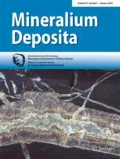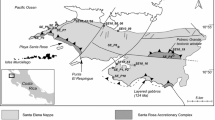Abstract
The Sungun porphyry copper deposit is hosted in a Diorite/granodioritic to quartz-monzonitic stock that intruded Eocene volcanosedimentary and Cretaceous carbonate rocks. Copper mineralization is associated mainly with potassic alteration and to a lesser extent with sericitic alteration. Based on previously published fluid inclusion and isotopic data by Hezarkhani and Williams-Jones most of the copper is interpreted to have deposited during the waning stages of orthomagmatic hydrothermal activity at temperatures of 400 to 300 °C. These data also indicate that the hydrothermal system involved meteoric waters, and boiled extensively. In this work, thermodynamic data are used to delineate the stability fields of alteration and ore assemblages as a function of fS2, fO2 and pH. The solubility of chalcopyrite was evaluated in this range of conditions using recently published experimental data. During early potassic alteration (>450 °C), Copper solubility is calculated to have been >50 000 ppm, whereas the copper content of the initial fluid responsible for ore deposition is estimated, from fluid inclusion data, to have been 1200–3800 ppm. This indicates that initially the fluid was highly undersaturated with respect to chalcopyrite, which agrees with the observation that veins formed at T > 400 °C contain molybdenite but rarely chalcopyrite. Copper solubility drops rapidly with decreasing temperature, and at 400 °C is approximately 1000 ppm, within the range estimated from fluid inclusion data, whereas at 350 °C it is only 25 ppm. These calculations are consistent with observations that the bulk of the chalcopyrite deposited at Sungun is hosted by veins formed at temperatures of 360 ± 60 °C. Other factors that, in principle, may reduce chalcopyrite solubility are increases in pH, and decreases in fO2 and aCl−. Our analysis shows, however, that most of the change in pH occurred at high temperature when chalcopyrite was grossly undersaturated in the fluid, and that the direction of change in fO2 increased chalcopyrite solubility. We propose that the Sungun deposit formed mainly in response to the sharp temperature decrease that accompanied boiling, and partly as a result of the additional heat loss and decrease in aCl−, which occurred as a result of mixing of acidic Cu-bearing magmatic waters with cooler meteoric waters of lower salinity.
Similar content being viewed by others
Author information
Authors and Affiliations
Additional information
Received: 8 July 1998 / Accepted: 8 April 1999
Rights and permissions
About this article
Cite this article
Hezarkhani, A., Williams-Jones, A. & Gammons, C. Factors controlling copper solubility and chalcopyrite deposition in the Sungun porphyry copper deposit, Iran. Mineral. Deposita 34, 770–783 (1999). https://doi.org/10.1007/s001260050237
Issue Date:
DOI: https://doi.org/10.1007/s001260050237




